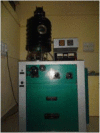Antiadherent and antibacterial properties of stainless steel and NiTi orthodontic wires coated with silver against Lactobacillus acidophilus--an in vitro study
- PMID: 26576557
- PMCID: PMC4648852
- DOI: 10.1186/s40510-015-0110-0
Antiadherent and antibacterial properties of stainless steel and NiTi orthodontic wires coated with silver against Lactobacillus acidophilus--an in vitro study
Abstract
Background: The purpose of the study is to assess the antiadherent and antibacterial properties of surface-modified stainless steel and NiTi orthodontic wires with silver against Lactobacillus acidophilus.
Methods: This study was done on 80 specimens of stainless steel and NiTi orthodontic wires. The specimens were divided into eight test groups. Each group consisted of 10 specimens. Groups containing uncoated wires acted as a control group for their respective experimental group containing coated wires. Surface modification of wires was carried out by the thermal vacuum evaporation method with silver. Wires were then subjected to microbiological tests for assessment of the antiadherent and antibacterial properties of silver coating against L. acidophilus. Mann-Whitney U test was used to analyze the colony-forming units (CFUs) in control and test groups; and Student's t test (two-tailed, dependent) was used to find the significance of study parameters on a continuous scale within each group.
Results: Orthodontic wires coated with silver showed an antiadherent effect against L. acidophilus compared with uncoated wires. Uncoated stainless steel and NiTi wires respectively showed 35.4 and 20.5 % increase in weight which was statistically significant (P < 0.001), whereas surface-modified wires showed only 4.08 and 4.4 % increase in weight (statistically insignificant P > 0.001). The groups containing surface-modified wires showed statistically significant decrease in the survival rate of L. acidophilus expressed as CFU and as log of colony count when compared to groups containing uncoated wires. It was 836.60 ± 48.97 CFU in the case of uncoated stainless steel whereas it was 220.90 ± 30.73 CFU for silver-modified stainless steel, 748.90 ± 35.64 CFU for uncoated NiTi, and 203.20 ± 41.94 CFU for surface-modified NiTi.
Conclusions: Surface modification of orthodontic wires with silver can be used to prevent the accumulation of dental plaque and the development of dental caries during orthodontic treatment.
Keywords: Antiadherent properties; Antibacterial properties; Lactobacillus acidophilus; Orthodontic wires; Silver coating.
Figures
Similar articles
-
In vitro assessment of photocatalytic titanium oxide surface modified stainless steel orthodontic brackets for antiadherent and antibacterial properties against Lactobacillus acidophilus.Angle Orthod. 2011 Nov;81(6):1028-35. doi: 10.2319/021111-101.1. Angle Orthod. 2011. PMID: 22007663 Free PMC article.
-
Antimicrobial effect, frictional resistance, and surface roughness of stainless steel orthodontic brackets coated with nanofilms of silver and titanium oxide: a preliminary study.Microsc Res Tech. 2017 Jun;80(6):599-607. doi: 10.1002/jemt.22835. Epub 2017 Feb 9. Microsc Res Tech. 2017. PMID: 28181353
-
Comparative short-term in vitro analysis of mutans streptococci adhesion on esthetic, nickel-titanium, and stainless-steel arch wires.Angle Orthod. 2014 Jul;84(4):680-6. doi: 10.2319/061713-456.1. Epub 2013 Dec 5. Angle Orthod. 2014. PMID: 24308530 Free PMC article.
-
Effects of mouthwashes on the morphology, structure, and mechanical properties of orthodontic materials: a systematic review of randomized clinical studies.Eur J Orthod. 2025 Jun 12;47(4):cjaf048. doi: 10.1093/ejo/cjaf048. Eur J Orthod. 2025. PMID: 40501275 Free PMC article.
-
Use of Antimicrobial Silver Coatings on Fixed Orthodontic Appliances, Including Archwires, Brackets, and Microimplants: A Systematic Review.Med Sci Monit. 2024 Jun 6;30:e944255. doi: 10.12659/MSM.944255. Med Sci Monit. 2024. PMID: 38843112 Free PMC article.
Cited by
-
Silver nanoparticles in orthodontics, a new alternative in bacterial inhibition: in vitro study.Prog Orthod. 2020 Aug 17;21(1):24. doi: 10.1186/s40510-020-00324-6. Prog Orthod. 2020. PMID: 32803386 Free PMC article.
-
The antibacterial effect of silver, zinc-oxide and combination of silver/ zinc oxide nanoparticles coating of orthodontic brackets (an in vitro study).BMC Oral Health. 2022 Jun 9;22(1):230. doi: 10.1186/s12903-022-02263-6. BMC Oral Health. 2022. PMID: 35681128 Free PMC article.
-
Multifunctional coatings of nickel-titanium implant toward promote osseointegration after operation of bone tumor and clinical application: a review.Front Bioeng Biotechnol. 2024 Feb 20;12:1325707. doi: 10.3389/fbioe.2024.1325707. eCollection 2024. Front Bioeng Biotechnol. 2024. PMID: 38444648 Free PMC article. Review.
-
Design and development of novel antibacterial Ti-Ni-Cu shape memory alloys for biomedical application.Sci Rep. 2016 Nov 29;6:37475. doi: 10.1038/srep37475. Sci Rep. 2016. PMID: 27897182 Free PMC article.
-
Evaluating the Mechanical Properties of Zinc-Coated Stainless Steel Orthodontic Wires Using Physical Vapor Deposition.Int J Dent. 2021 May 3;2021:6651289. doi: 10.1155/2021/6651289. eCollection 2021. Int J Dent. 2021. PMID: 34054962 Free PMC article.
References
-
- Menzaghi N, Saletta M, Garattini G, Brambilla E, Strohmenger L. Changes in the yeast oral flora in patients in orthodontic treatment. Prev Assist Dent. 1991;17:26–30. - PubMed
Publication types
MeSH terms
Substances
LinkOut - more resources
Full Text Sources
Other Literature Sources
Medical





